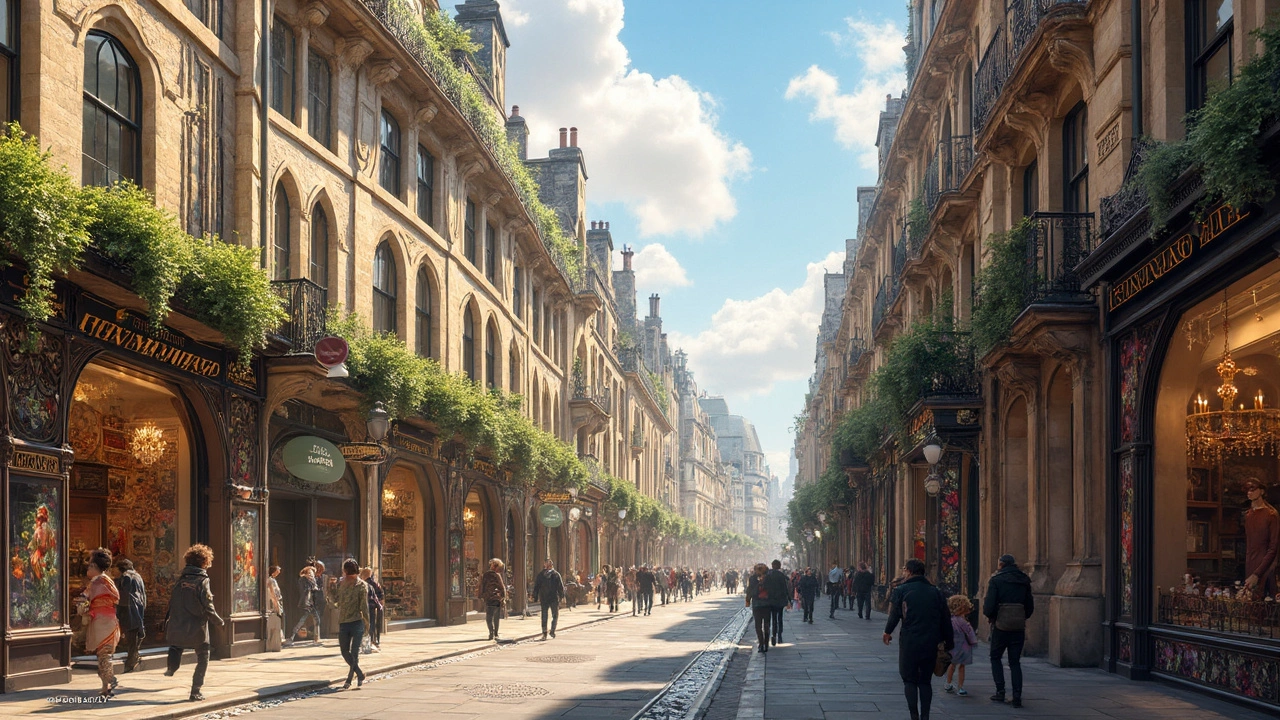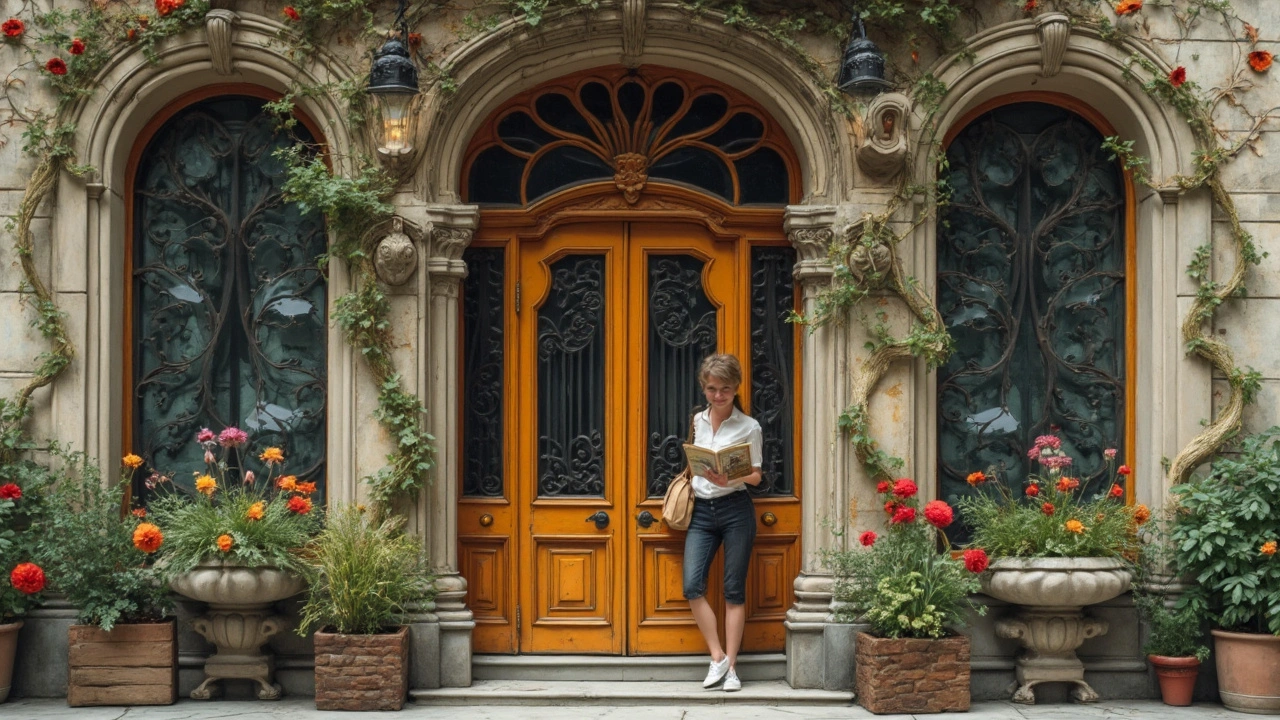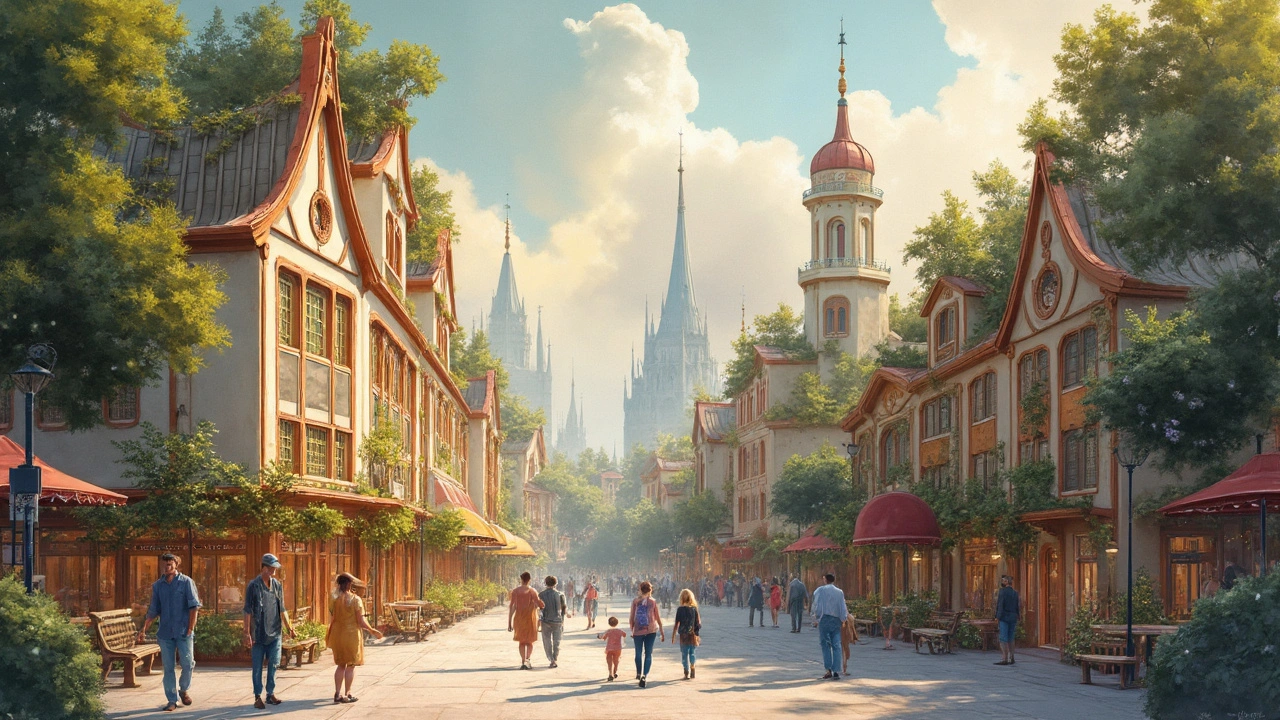Art Nouveau Architecture: A Unique Blend of Art and Function
 May, 10 2025
May, 10 2025
You can't help but notice Art Nouveau buildings once you know what to look for—think doorways twisting like vines, windows with curvy edges, and railings that feel almost alive. But why did architects start building this way in the late 1800s and early 1900s?
The answer is pretty simple: they wanted design that felt fresh. People were tired of copying old styles. Art Nouveau was all about using new materials like iron and glass, decorating walls and staircases with flowers and insects, and making sure even a lamp post looked interesting—not just useful.
If you've ever walked by a building that seemed to ripple or have a bit of fantasy to it, there's a good chance you’ve seen an Art Nouveau masterpiece. Even elevators and street lamps became works of art during this era. These places still draw crowds today. Travelers love spotting the style on vacation, but with a few tricks, you might notice it hiding in your own city too.
- The Birth of Art Nouveau Architecture
- Signature Features and Design Elements
- Famous Art Nouveau Buildings You Can Visit
- How to Spot Art Nouveau in Your City
- Tips for Bringing Art Nouveau Style Home
The Birth of Art Nouveau Architecture
Art Nouveau didn’t just pop up out of nowhere. It grew out of a real desire to shake up how people designed buildings and everyday things. Back in the late 1800s, Europe was buzzing with new inventions and technology. This was the era of trains, electricity, and steel frames. But on the style front, everything still looked old-fashioned—lots of classical columns and stuffy Victorian touches.
By the 1890s, there was a growing crowd of architects and artists who wanted something modern, something that broke free from the past. They took inspiration from natural shapes instead of straight lines or heavy decorations. That’s how the Art Nouveau style started rolling. The name itself comes from a Paris shop called "Maison de l’Art Nouveau," which opened in 1895 and became a kind of headquarters for the movement.
This wasn’t just a local trend. You’ll hear Art Nouveau called "Jugendstil" in Germany, "Secession" in Austria, and "Modernismo" in Spain. Whatever the name, the goal was the same: mix art and function, make things look organic, and bring creativity into daily life.
Cities like Brussels, Paris, and Barcelona jumped on this new wave. In Belgium, architect Victor Horta started using iron and glass in creative ways, turning staircases and skylights into the stars of his buildings. In Spain, Antoni Gaudí took the movement even further, making houses and churches look almost like they grew out of the earth.
Want to get a sense of how quickly Art Nouveau spread? Check out these early dates for key buildings:
| Building Name | City | Year Built |
|---|---|---|
| Hôtel Tassel | Brussels | 1893 |
| Casa Batlló | Barcelona | 1904 |
| Secession Building | Vienna | 1898 |
| Majolikahaus | Vienna | 1898 |
If you’re curious why Art Nouveau feels so different, it all started with that push to make buildings more creative and less stuck in the past. The movement only lasted about 30 years, but the change it brought is still easy to see whenever you spot those flowing lines and quirky details around the city.
Signature Features and Design Elements
Walk past an Art Nouveau building and you’ll see right away what makes it special. This style leans hard on curved lines and shapes inspired by plants and animals. Straight edges take a backseat—everything feels like it’s moving, bending, or growing. If you spot a front door that looks like it’s been taken over by tree roots, you’re on the right track.
Key elements show up again and again in Art Nouveau architecture:
- Organic lines: You’ll see wavy, whiplash curves almost everywhere—on windows, rooftops, balconies, and even inside on stair railings.
- Nature themes: Flowers, leaves, bugs, and peacock feathers are favorite details, either painted, carved, or used as patterns in glasswork.
- New materials: Architects used iron, ceramics, and glass in ways that hadn’t been common before, which let them do things no one had tried—think big, open spaces and see-through walls with colored glass.
- Handcrafted details: Compared to mass-produced buildings from the same era, Art Nouveau shows off the skill of individual artists and craftsmen. Door handles, tiles, and even mailboxes got the special treatment.
- Asymmetry: Unlike old-school buildings that were perfectly balanced, Art Nouveau wasn’t afraid to be a little lopsided. This made things look more natural and interesting.
These days, restoration experts estimate that about 15% of the historical buildings protected in cities like Brussels or Riga are classic Art Nouveau, according to local cultural reports from 2023. To help you spot these details, here's a quick breakdown:
| Feature | Where You'll See It | Common Example |
|---|---|---|
| Curved lines | Balconies, windows, railings | Casa Batlló’s bone-like windows (Barcelona) |
| Nature themes | Tiles, wall carvings, light fixtures | Iris flowers on Brasserie Julien’s glass panels (Paris) |
| Colored glass | Entrances, skylights | Stained-glass skylight of the Hotel Métropole (Brussels) |
| Handcrafted ironwork | Gates, doors, staircases | Iron railings at Majolikahaus (Vienna) |
If you’re curious, take a walk through your own neighborhood and see if you can spot even one of these details. Art Nouveau pops up in surprising places, from old train stations to forgotten bakeries. Try looking up above street level—some of the best details are right over your head.

Famous Art Nouveau Buildings You Can Visit
If you’re curious about how Art Nouveau looks in real life, nothing beats visiting some of its most famous spots. Many cities in Europe became playgrounds for architects who loved experimenting. You’ll find works of art where you’d least expect them — on office buildings, houses, and even metro stations.
Barcelona’s Casa Batlló is a must-see. Designed by Antoni Gaudí in 1904, locals call it the “House of Bones” because the balconies and columns really do look like skeletons. It sits right in the middle of Passeig de Gràcia, so it’s tough to miss. The roof is covered in scales, kind of like a dragon, making it Insta-worthy from every angle. Walk a few blocks, and you’ll spot other buildings by Gaudí shifting the vibe from ordinary to wild.
Over in Brussels, Victor Horta changed the game with the Hôtel Tassel. Opened in 1893, it’s everything Art Nouveau stands for: open layouts, glass skylights, and those famous ‘whiplash’ curves everywhere you look. Even the stair railings have been copied by designers all over the world.
Take a trip to Riga, Latvia, if you really want to be blown away. Riga is sometimes called the Art Nouveau capital of Europe, with over 800 preserved buildings. Streets like Alberta iela feel like open-air design museums — almost every building jumps out with bold faces, flowers, and endless swirls on their facades.
Budapest does Art Nouveau its own way. Don’t miss the Gresham Palace, now a luxury hotel. You can sneak into the lobby for a peek at stained glass skylights and fancy mosaics, even if you’re not staying overnight.
- Casa Batlló (Barcelona, Spain): Gaudí’s wild, colorful house inspired by bones and ocean life.
- Hôtel Tassel (Brussels, Belgium): Victor Horta’s blueprint for modern Art Nouveau architecture.
- Alberta iela (Riga, Latvia): Street lined with dramatic facades and sculpted details.
- Gresham Palace (Budapest, Hungary): Grand, elegant building full of stained glass and mosaics.
- Majolikahaus (Vienna, Austria): Apartment block with a bright floral ceramic tile exterior, by Otto Wagner.
Here’s a quick look at must-see buildings and where to find them:
| Building | City | Year Built | Architect | Fun Fact |
|---|---|---|---|---|
| Casa Batlló | Barcelona | 1904-1906 | Antoni Gaudí | Features a roof shaped like a dragon’s back |
| Hôtel Tassel | Brussels | 1892-1893 | Victor Horta | Often called the first true Art Nouveau building |
| Gresham Palace | Budapest | 1906 | Zsigmond Quittner | Now houses the Four Seasons hotel |
| Majolikahaus | Vienna | 1898 | Otto Wagner | Name comes from the glazed ceramic tiles on the outside |
| Alberta iela | Riga | Early 1900s | Multiple Architects | Street has one of the highest concentrations of Art Nouveau in the world |
If you can’t hop on a plane right now, a quick online search will let you do virtual tours of most of these places. Many travel blogs even offer step-by-step guides for walking routes so you won’t miss the best views. Next time you plan a trip, add at least one of these to your list. They’re way more interesting than your typical sightseeing stop.
How to Spot Art Nouveau in Your City
Finding Art Nouveau architecture is honestly like going on a treasure hunt. Even if you’re not in Paris or Barcelona, surprises can pop up in regular neighborhoods. You just need to know what to scan for. The easiest signs are all about pattern and decoration—nothing is boring or blocky. Here’s what to watch for on your next walk:
- Curvy lines everywhere: Window frames, doorways, and balconies are rarely straight and square. Instead, look for shapes that remind you of vines or waves.
- Nature on walls: Architects loved adding carved flowers, leaves, dragonflies, or birds to everything from tiles to ironwork. Marc Chagall once joked that Art Nouveau houses looked like "gardens with a roof."
- Asymmetry that works: Things aren’t always perfectly matched on both sides, but somehow it feels balanced. You might see a big window on one side, and just a small one across from it.
- Unusual materials: Instead of plain brick or stone, check for colored glass, ceramic tiles, and lots of shiny metal details.
- Fancy fonts: House numbers or signs often use swooping, playful fonts you don’t see anywhere else.
If you’re curious about where these buildings show up, here’s a quick look at some cities with famous examples and the years when the most were built:
| City | Famous Example | Main Period |
|---|---|---|
| Brussels | Hôtel Tassel | 1892–1900 |
| Paris | Castel Béranger | 1895–1910 |
| Riga | Elizabetes iela 10b | 1899–1914 |
| Barcelona | Casa Batlló | 1904–1906 |
Here’s a tip: Some of the best spots aren’t the big museums but regular apartment buildings, old bakeries, or even metro stations. Snapping photos is a great way to start a collection of cool finds. If you want to dive deeper, check your local library—there might be a walking tour or old guidebook hiding on the shelf.
Once you start noticing these quirks, you’ll see how one design trend from more than a hundred years ago can still make everyday streets way more interesting.

Tips for Bringing Art Nouveau Style Home
So, maybe you can’t live in a historic Art Nouveau mansion, but you can bring a lot of its vibe into your own space. The cool thing about this style is that it isn’t just for giant buildings—it works for apartments, condos, and even houses in the suburbs.
Here are some no-nonsense ideas to add true Art Nouveau flair where you live:
- Curvy lines are key. Add mirrors or picture frames with smooth, flowing shapes. It should look like a natural curve, not a stiff border.
- Nature is your best friend. The most famous Art Nouveau designers used flowers, leaves, and insects as inspiration. Think wall art, rugs, or wallpapers with big, plant-like patterns.
- Stained glass isn’t just for old churches. You can find stained glass lamps, or even window decals, that channel that signature colorful look. Louis Comfort Tiffany’s lamps became icons because of this.
- Look for metalwork with a twist. Swap out cabinet handles or a light fixture for something with a little swirl or leaf motif. Even modern stores are making hardware in this style, so it doesn’t have to cost a fortune.
- When it comes to color, go for earthy greens, golds, muted blues, and warm browns. These shades keep things cozy but stylish, just like original Art Nouveau rooms.
The best part? Art Nouveau is about blending beauty with function. Don’t buy something that just looks pretty—find a lamp, chair, or mirror you’ll actually use, and let that be the standout piece. Skip plastic or harsh lines; look for quality and softness in the details. With a few smart swaps, your home can feel a little more like Paris or Barcelona—no plane ticket required.